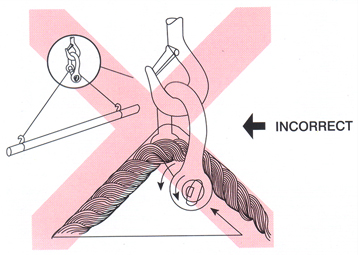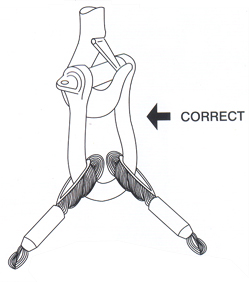Select the correct type of shackle for the particular application, from information given in sub-section and following notes.
Shackles should be fitted to the load in a manner that allows the shackle body to take the load in a true line along its centre line; and not in such a that bending loads are reduced, other than those for which the shackle is designed.

If the load shifts the sling will unscrew the shackle pin.
To avoid eccentric loading of the shackle a loose spacer may be used on either end of the shackle pin or a shackle with a smaller jaw width should de used. Do not reduce the width between the shackle jaw by welding washers or spacers to the inside faces of the eyes or by closing jaws, as this will have an adverse effect on the properties of the shackle. If the load shifts the sling will unscrew the shackle pin.
When a shackle is used to secure the top block of a set of rope blocks the load on this shackle is increased by the value of the hoisting effort.
|
|
When using shackles in conjunction multi- slings, due consideration must be given to the effect of the angle between the legs of the sling. As the angle increases so does the load in the leg and consequently in any shackle attached to that leg.
Note: In the case of higher tensile steel shackle, it is permissible under the supervision of a Competent Person to have the jaw width closed in by a blacksmith, provided that the shackle is subsequently subjected to the appropriate heat treatment, tested, examined and certified. The shackle pin would also require modification.

Use two ropes with eyes as required by Construction Lifting Operations
Avoid applications where due to movement (e. g. of the load or rope) the shackle pin can roll and possibly unscrew.
Shackle pin bearing on
running line can work loose.
Shackle pin cannot turn.
|